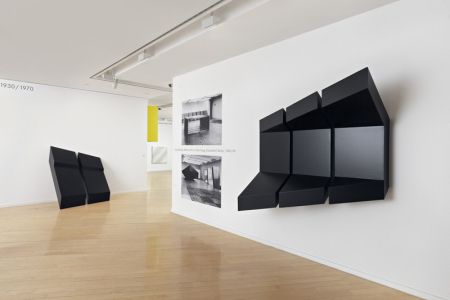MINIMALISM IN GERMANY. THE SIXTIES
II
Abstraction and Seriality, Zero, Concrete Tendencies and Sculpture as Action
Daimler Contemporary
Haus Huth
Alte Potsdamer Straße 5 - Berlin
31 March – 9 September 2012
The first exhibition in the 'Minimalism Germany 1960 series in 2010 comprehensively showed major trends in reduced, abstract 1960s art in Germany from the Daimler Art Collection. The second part concentrates on a small number of protagonists who essentially represent a specifically German aspect of Minimalism as an international trend in the 1960s with large-scale work, serial picture objects and action-oriented work concepts. The exhibition takes the example of striking protagonists, bringing together about 40 works to reflect on trends in Conceptual Art, Minimalism and seriality, linked with the cities of Frankfurt, Düsseldorf, Hamburg, Stuttgart and Berlin.
An independent form of Minimalism developed in 1960s Germany by addressing abstraction and Zero avantgarde, constructive and concrete tendencies, and was stimulated by the work of Joseph Beuys. The accompanying publication is devoted to selected reductionist works by German artists of the period, with about 100 works by roughly 40 artists, mainly from the Daimler Art Collection holdings. Essays on Minimalist tendencies in architecture, literature, film and design in 1960s Germany develop a broader context over and above this.
Participating artists: Hartmut Böhm, Hanne Darboven, Hermann Glöckner, Mathias Goeritz, Heinz Mack, Charlotte Posenenske, Peter Roehr, Ulrich Rückriem, Eckhard Schene, Helmut Stromsky, Franz Erhard Walther.
Accompanying the exhibition a book will be published in may ‘Minimalism in Germany. The Sixties II’ Ed. Renate Wiehager Texts by Renate Wiehager and Susannah Cremer-Bermbach, Norbert Grob, Paul Kayser, Hans Mayer, Gregor Stemmrich, Franz Erhard Walther et.al., about 460 pages, HatjeCantz).
Abstraction and Seriality, Zero, Concrete Tendencies and Sculpture as Action
Daimler Contemporary
Haus Huth
Alte Potsdamer Straße 5 - Berlin
31 March – 9 September 2012
The first exhibition in the 'Minimalism Germany 1960 series in 2010 comprehensively showed major trends in reduced, abstract 1960s art in Germany from the Daimler Art Collection. The second part concentrates on a small number of protagonists who essentially represent a specifically German aspect of Minimalism as an international trend in the 1960s with large-scale work, serial picture objects and action-oriented work concepts. The exhibition takes the example of striking protagonists, bringing together about 40 works to reflect on trends in Conceptual Art, Minimalism and seriality, linked with the cities of Frankfurt, Düsseldorf, Hamburg, Stuttgart and Berlin.
An independent form of Minimalism developed in 1960s Germany by addressing abstraction and Zero avantgarde, constructive and concrete tendencies, and was stimulated by the work of Joseph Beuys. The accompanying publication is devoted to selected reductionist works by German artists of the period, with about 100 works by roughly 40 artists, mainly from the Daimler Art Collection holdings. Essays on Minimalist tendencies in architecture, literature, film and design in 1960s Germany develop a broader context over and above this.
Participating artists: Hartmut Böhm, Hanne Darboven, Hermann Glöckner, Mathias Goeritz, Heinz Mack, Charlotte Posenenske, Peter Roehr, Ulrich Rückriem, Eckhard Schene, Helmut Stromsky, Franz Erhard Walther.
Accompanying the exhibition a book will be published in may ‘Minimalism in Germany. The Sixties II’ Ed. Renate Wiehager Texts by Renate Wiehager and Susannah Cremer-Bermbach, Norbert Grob, Paul Kayser, Hans Mayer, Gregor Stemmrich, Franz Erhard Walther et.al., about 460 pages, HatjeCantz).
